More than 46 million homes in the U.S. include a cat, showcasing the immense popularity of these feline companions. However, for individuals with allergies, the dream of cat ownership can often be overshadowed by sneezing, itching, and other allergic reactions. While the concept of a completely hypoallergenic cat is a myth, certain breeds are recognized as “hypoallergenic” due to their tendency to produce fewer allergens, making them potentially more compatible for allergy sufferers.
What Is a Hypoallergenic Cat?
It’s crucial to understand that no cat breed is truly 100% hypoallergenic. All cats produce allergens, primarily through a protein known as Fel d 1, found in their fur, saliva, and urine. These allergens are the culprits behind allergic reactions in sensitive individuals. However, “Hypoallergenic Cat Breeds” are those that produce lower levels of these proteins, or have coat types that trap dander more effectively, thus reducing the amount of allergens released into the environment. Therefore, while they might not eliminate allergies entirely, these breeds can significantly lessen allergic reactions for some people.
12 Cat Breeds Considered Hypoallergenic
If you’re an allergy sufferer yearning for a feline companion, exploring hypoallergenic breeds is a great starting point. Remember that individual reactions can vary, so spending time with a cat of the desired breed before bringing them home is always recommended to assess your personal allergy response. Here are 12 breeds often cited as being hypoallergenic:
1. Siberian
Siberian cats, despite their luxuriously thick, long coats, are surprisingly considered a top hypoallergenic breed. This is because they produce less Fel d 1 protein in their saliva compared to many other breeds. Their dense coat, while requiring regular grooming, traps dander effectively. Beyond their hypoallergenic qualities, Siberians are known for their affectionate, friendly, and playful nature, making them wonderful family pets. Their gentle temperament and adaptability make them well-suited to households with children and other pets. Regular brushing is essential to manage their long fur and minimize shedding.
2. Siamese
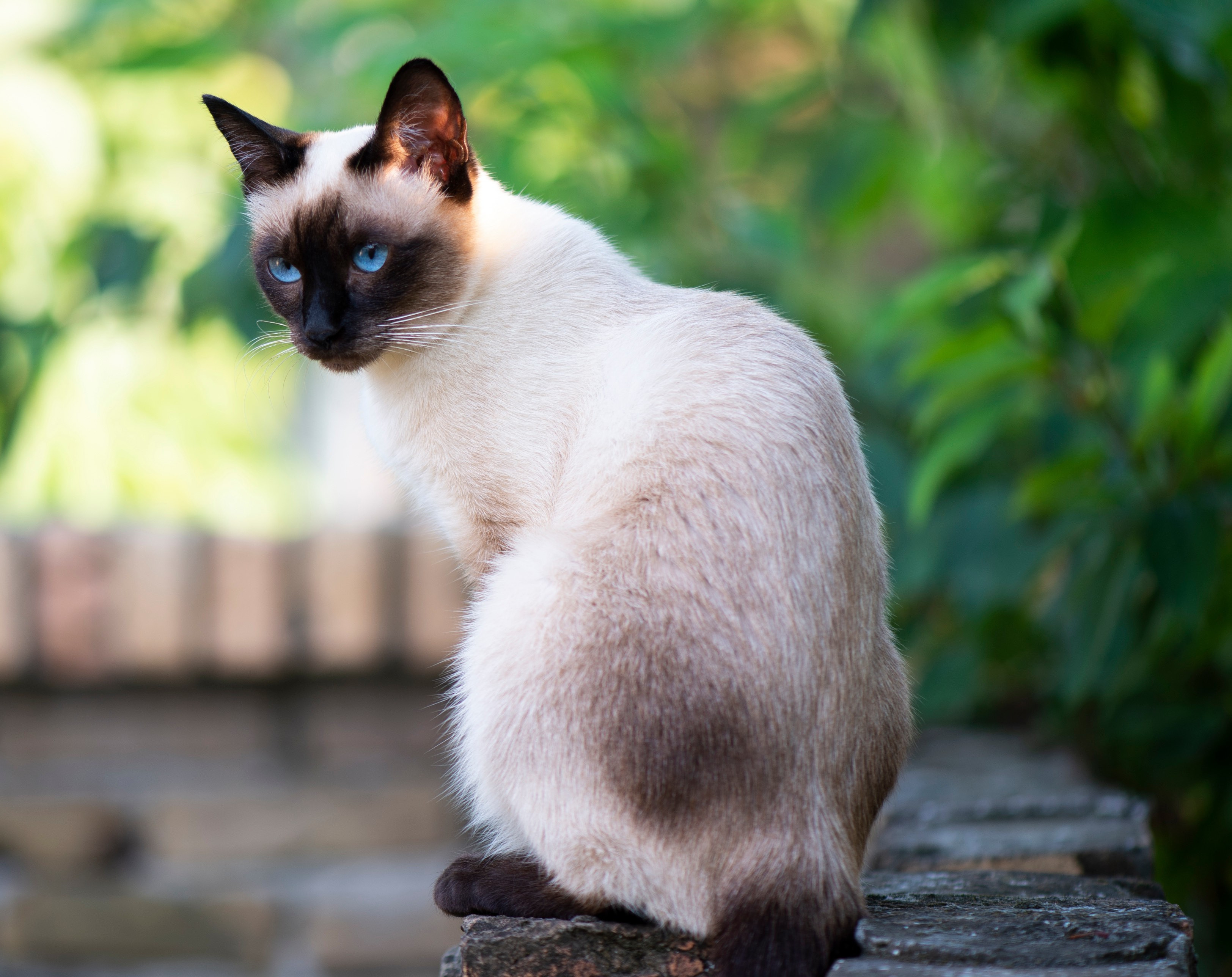 siamese cat sitting outside
siamese cat sitting outside
The elegant Siamese cat is another breed often recommended for allergy sufferers. Their short, fine coat sheds minimally, which translates to fewer allergens being dispersed around your home. While no cat is entirely non-shedding, the Siamese’s coat type contributes to a lower allergen load compared to heavily shedding breeds. Siamese cats are renowned for their striking blue almond-shaped eyes and vocal personalities. They are highly intelligent, social, and form strong bonds with their families. However, their demanding nature means they thrive on attention and might not be ideal for households frequently empty. A balanced diet formulated for Siamese cats can further support their health and well-being.
3. Bengal
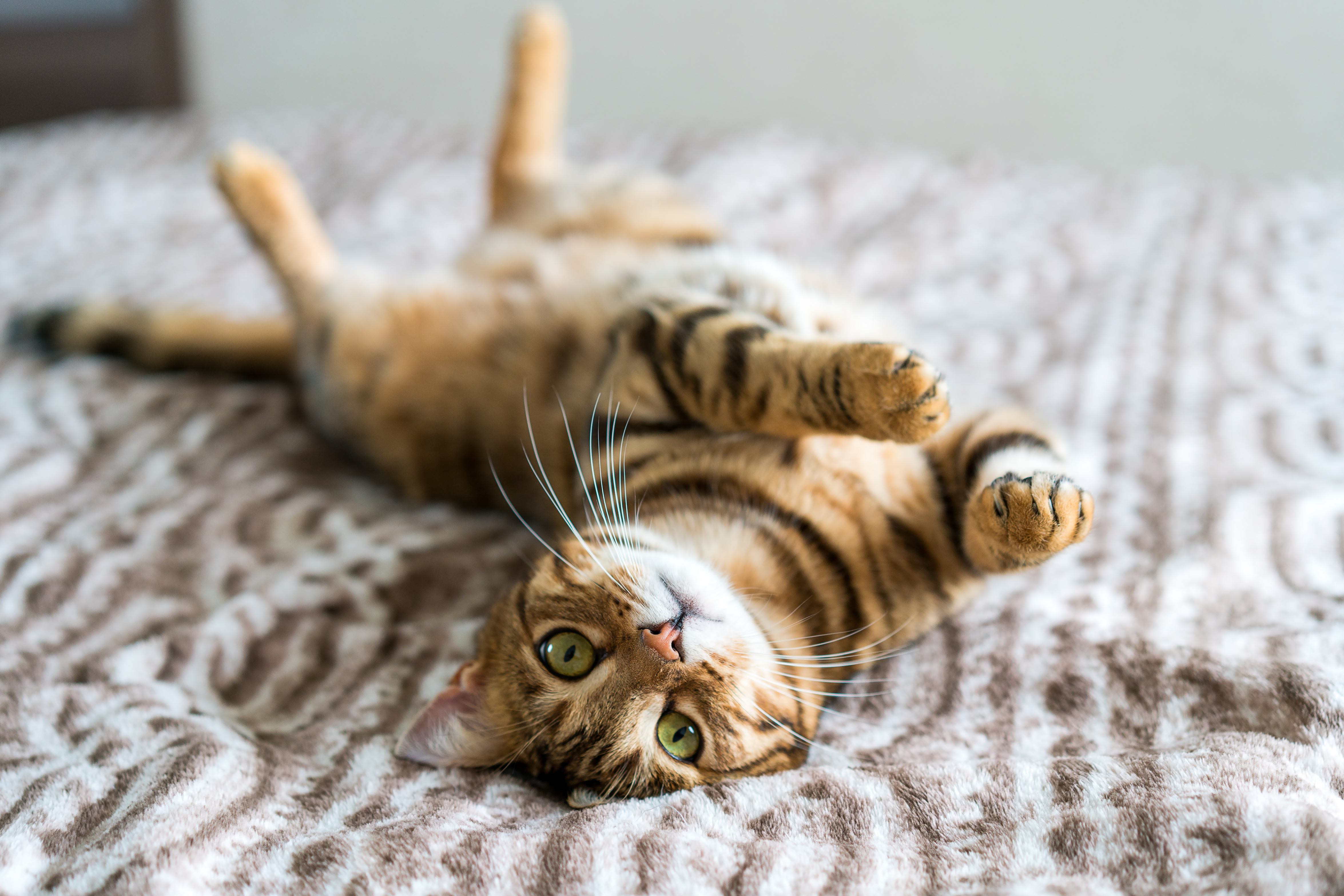 bengal cat lying on a bed on his back and showing his stomach
bengal cat lying on a bed on his back and showing his stomach
Bengal cats are truly unique, boasting a stunning spotted or marbled coat reminiscent of their Asian Leopard Cat ancestry. This exotic appearance is coupled with hypoallergenic qualities, as their short, sleek coat sheds very little. Like other breeds on this list, the reduced shedding contributes to fewer allergens in the environment. Bengals are known for their high energy levels, intelligence, and playful personalities. They are curious and active cats who need plenty of stimulation and interaction. Prospective Bengal owners should be aware of their energetic nature and potential regulations in some areas concerning ownership due to their wild ancestry. Breed-specific diets are available to cater to their unique nutritional needs.
4. Russian Blue
 russian blue cat headbutting a man
russian blue cat headbutting a man
Russian Blue cats are prized for their striking silvery-blue coat, emerald green eyes, and gentle temperament. They are considered hypoallergenic due to their dense, plush double coat that traps dander close to their skin, minimizing airborne allergens. Russian Blues are also known to produce less Fel d 1 protein. These cats are affectionate and loyal to their families, but can be initially reserved with strangers. Their quiet and calm nature makes them excellent indoor companions. While they are low-shedding, regular gentle grooming helps maintain their coat’s health and beauty and further reduces loose hair.
5. Sphynx
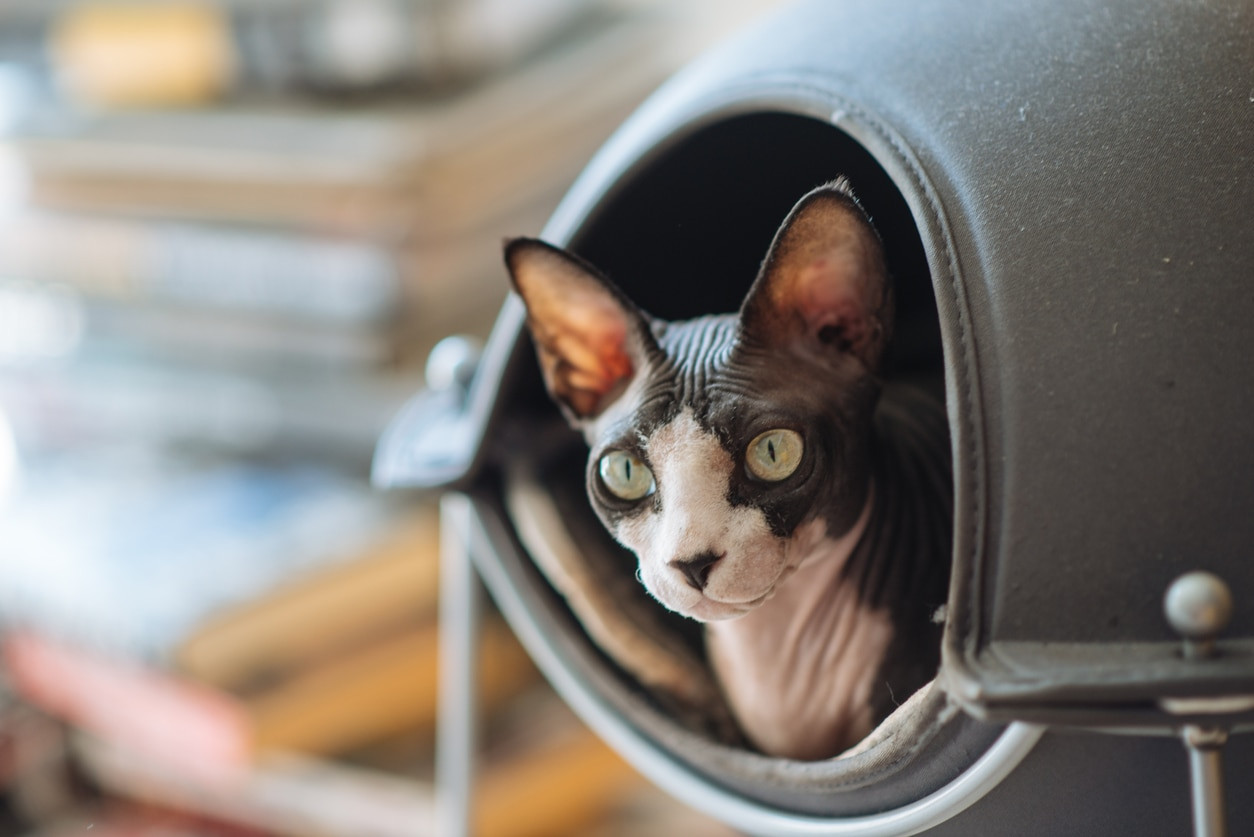 black and pink sphynx cat looking out of a covered cat bed
black and pink sphynx cat looking out of a covered cat bed
The Sphynx cat stands out dramatically with its hairless appearance, which is the primary reason they are considered hypoallergenic. While not truly hairless – they often have a fine layer of downy fuzz – their lack of fur means there is less hair to trap and shed dander, a major source of allergens. However, it’s important to note that Sphynx cats still produce allergens in their saliva and skin secretions. Sphynx cats are incredibly affectionate, social, and attention-seeking. They are often described as dog-like in their devotion and playful antics. Despite lacking fur, they require regular bathing to remove oil buildup on their skin and maintain hygiene.
6. Devon Rex
 woman holding a devon rex cat like a baby
woman holding a devon rex cat like a baby
Devon Rex cats are characterized by their distinctive wavy, soft coat and large ears. This unique coat type, which is shorter and less dense than many breeds, contributes to their hypoallergenic reputation. They shed minimally, reducing the amount of allergens released into the home. Devon Rex cats are known for their playful, mischievous, and people-oriented personalities. They are intelligent and enjoy interactive play and human companionship. They can be quite active and require attention, so they thrive best in homes where they receive ample interaction.
7. Cornish Rex
Similar to the Devon Rex, Cornish Rex cats possess a fine, wavy coat that lies close to the body. This coat type sheds very little, making them another excellent choice for allergy sufferers. Cornish Rex cats are often described as having a suede-like feel to their fur. They are known for their affectionate, outgoing, and playful nature. Cornish Rex cats are also intelligent and energetic, requiring plenty of playtime and mental stimulation. They are often described as kitten-like throughout their lives, maintaining a playful and curious disposition. Regular grooming is still beneficial to keep their coat healthy and minimize any loose hair.
8. Javanese
 gray javanese cat mom grooming her kittens
gray javanese cat mom grooming her kittens
Javanese cats, closely related to Siamese and Balinese breeds, are considered hypoallergenic despite having a medium-long single coat. Their single coat means they lack an undercoat, resulting in less shedding and therefore fewer allergens released into the environment. Javanese cats are intelligent, vocal, and highly people-oriented. They are playful and energetic, enjoying interaction and attention from their families. Despite their longer coat, they are relatively low-maintenance in terms of grooming, though regular brushing is still recommended to prevent tangles and minimize shedding.
9. Balinese
The Balinese cat is often referred to as the “longhaired Siamese” due to their striking resemblance and shared ancestry. Despite their elegant, flowing long coat, they are considered hypoallergenic. Like Siamese cats, Balinese produce less Fel d 1 protein. Their fine, silky coat also sheds less than many long-haired breeds. Balinese cats are intelligent, affectionate, and social. They are known for their graceful appearance and gentle nature, making them wonderful companions for families and individuals alike. They can be trained and enjoy interactive play.
10. Oriental Shorthair
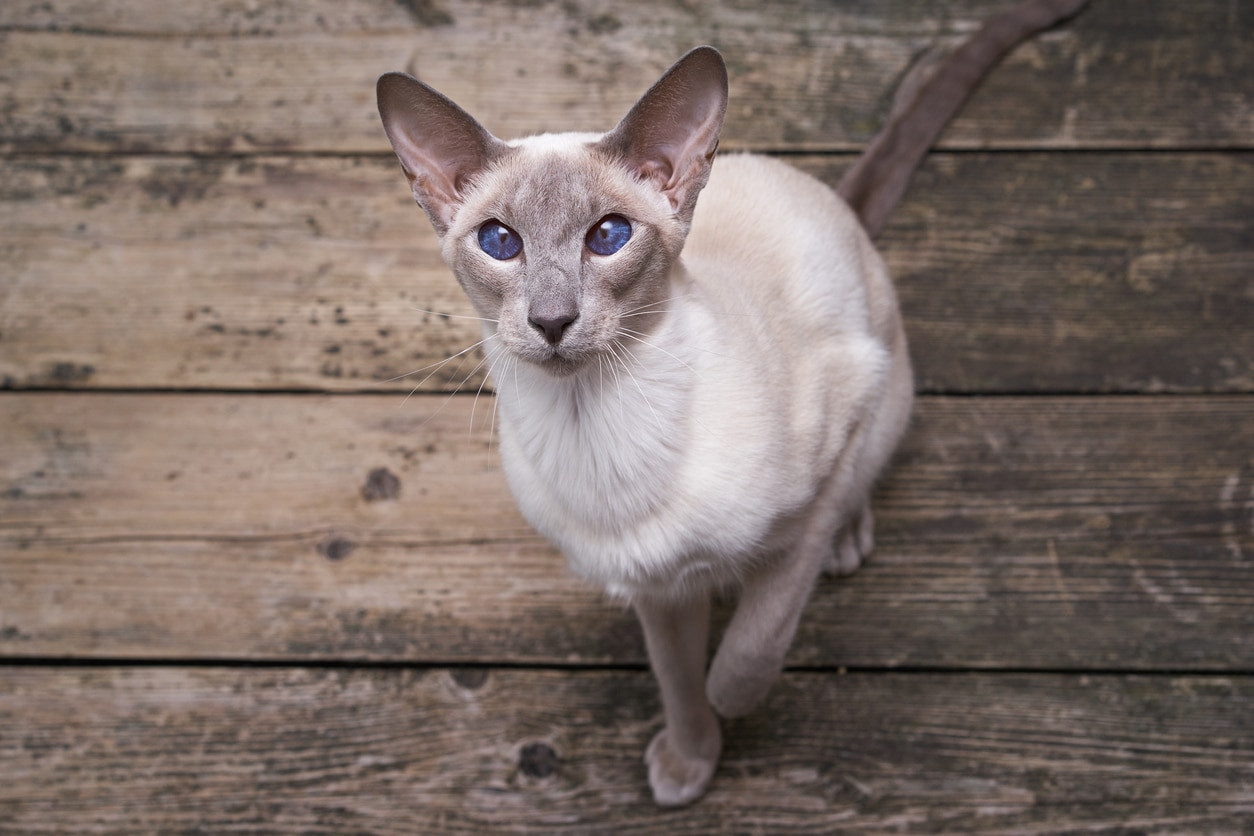 gray and white oriental shorthair cat looking up at the camera
gray and white oriental shorthair cat looking up at the camera
Oriental Shorthair cats are known for their sleek, elegant appearance and large, expressive ears. Their short, fine coat requires minimal grooming and sheds very little, contributing to their hypoallergenic status. Oriental Shorthairs are intelligent, curious, and playful cats. They are highly social and thrive on human interaction, often forming strong bonds with their families. They are known for their distinctive vocalizations, sometimes described as a honking sound, adding to their unique charm.
11. Burmese
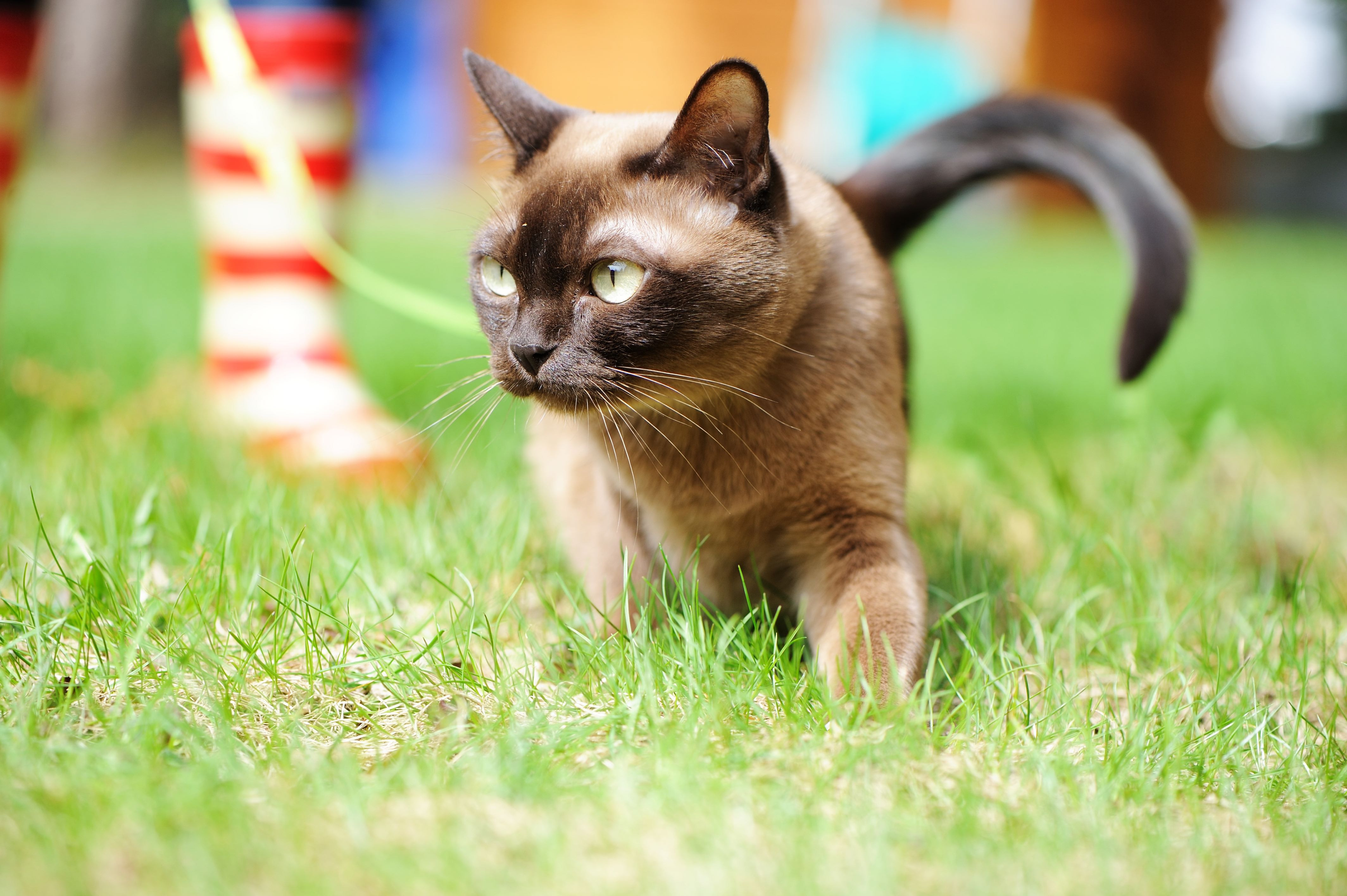 burmese cat walking on a leash and harness outside
burmese cat walking on a leash and harness outside
Burmese cats have a short, satin-like coat that is low-shedding and requires minimal grooming, making them a hypoallergenic breed option. They are known for their muscular build and sweet, affectionate personalities. Burmese cats are intelligent, playful, and enjoy being around people. They are often described as being dog-like in their loyalty and desire for companionship. They are energetic cats who need regular playtime and interaction to stay happy and healthy.
12. Tonkinese
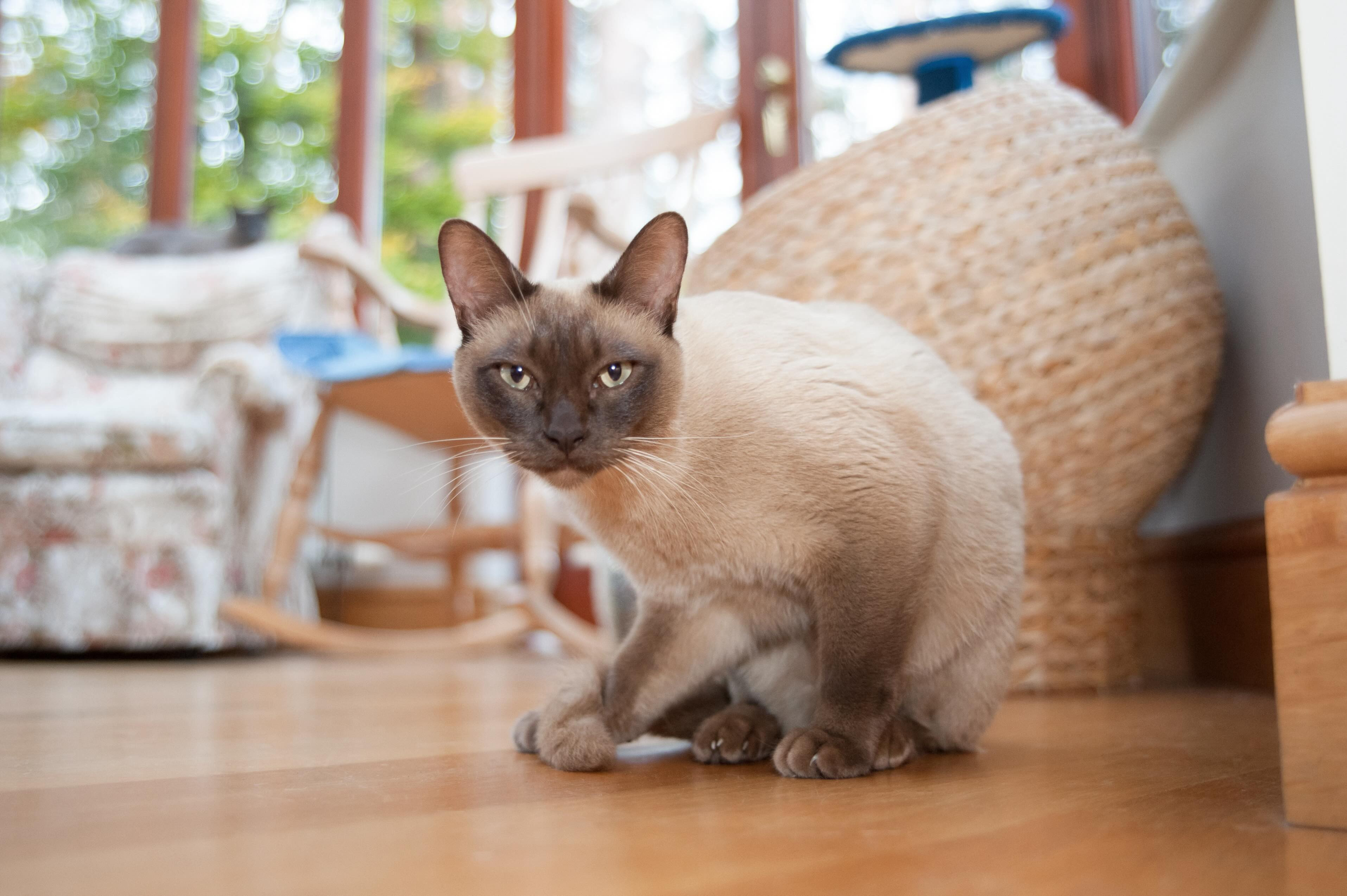 champagne tonkinese cat sitting on the floor and looking straight at the camera
champagne tonkinese cat sitting on the floor and looking straight at the camera
Tonkinese cats are a delightful blend of Siamese and Burmese traits. Their short, fine coat is low-shedding, contributing to their hypoallergenic qualities. Tonkinese cats are known for their lively, playful, and affectionate personalities. They are intelligent and social, enjoying interaction and attention from their families. Like their parent breeds, they can be vocal and are best suited to homes where they will receive plenty of attention and playtime.
Tips for Adopting a Hypoallergenic Cat
Choosing a hypoallergenic breed is just the first step. Managing allergies and living comfortably with a cat requires a multifaceted approach.
Do Your Research and Spend Time with the Cat
Thorough research into hypoallergenic breeds is crucial. However, remember that individual cats within a breed can still vary in allergen production. The most important step is to spend time with the specific cat you are considering adopting before bringing them home. This direct interaction will help you gauge your allergic reaction and determine if that particular cat is a good fit for you.
Consult With Your Allergy Specialist
Before bringing a cat into your home, it’s wise to consult with an allergist. They can help assess the severity of your allergies and advise on management strategies. They may also recommend allergy testing to pinpoint specific triggers and suggest medications or therapies to help manage your symptoms effectively.
Maintain a Clean Home Environment
Regular cleaning is essential in minimizing allergens in your home. While hypoallergenic cats shed less, they still produce dander and saliva. Frequent vacuuming, especially with a HEPA filter vacuum, dusting, and washing bedding and cat toys can significantly reduce allergen levels. Consider using air purifiers with HEPA filters to further cleanse the air of allergens.
Discuss Diet with Your Veterinarian
Innovative cat food options, such as Purina® Pro Plan® LIVECLEAR, are formulated to reduce Fel d 1 production in cats. This specialized diet can be a valuable tool in managing cat allergies. Consulting with your veterinarian about incorporating such a diet into your cat’s feeding regimen can be beneficial in further reducing allergen exposure.
FAQs About Cats and Shedding
Are there any non-shedding cats?
Truly non-shedding cats, in the sense of losing no hair at all, are rare. The Sphynx cat, often described as hairless, comes closest, though they still have fine down. Even breeds that don’t shed fur profusely still produce dander, saliva, and urine, all of which contain allergens.
Can cats be 100% hypoallergenic?
No, despite the term “hypoallergenic,” no cat breed is completely allergen-free. All cats produce allergens to varying degrees. Hypoallergenic breeds simply produce fewer allergens or release them less readily into the environment, potentially making them more tolerable for individuals with allergies.
WRITTEN BY:

